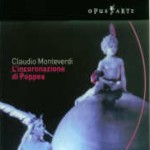This almost uncut version of Monteverdi’s (possibly) final opera is musically so handsomely and vividly performed that it’s a pity the visual production and director’s attitude toward the piece is so out of synch with the music. At first it seems intriguing: The sets by Michael Simon consist of huge forms–a globe, a triangle, pillars of fire, a blank wall–standing for gardens, the senate, bedroom, etc.; in other words, there is no sensual reality except in the minds and eyes of our characters who have to accept this stark world. The characters never touch and often don’t appear to be singing to one another. I guess it goes along with director Pierre Audi’s feeling that the characters are lonely and isolated (he tells us this in an interview, included), but it’s not what text and music are telling us. Even in the final, rapturous duet, Poppea and Nero sing to themselves until near the very end.
The costumes by Emi Wada are just as off-putting; this could be The Love for Three Oranges or some other wacky farce. Perhaps the entire point is to make us feel that we are watching a world made up of Nero’s and Poppea’s evil, not-quite-human fantasies; but if that’s the case, it doesn’t underline that enough. It is endlessly interesting to look at but it won’t remind you of what’s being sung or by whom.
But the playing and singing! The ensemble Les Talens Lyriques is enormously comfortable with this music and plays, correctly, as if it were commenting on the action of the singers. Christophe Rousset takes a relaxed view of tempos and uses a light orchestra, with rare excursions outside of the solid continuo section, which includes an organ. When recorders and cornets show up, they are a delightful addition of color. The opera seems to be given complete and it is a long evening. The story unfolds as you might read a novel, and some listeners might find it lacking urgency.
Brigitte Balleys and Cynthia Haymon, as Nero and Poppea, are wonderful. At times the former is insanely macho, at others, outrageously feminine, and we watch as Nero becomes crazier and crazier. And Haymon’s sound is both elegant and insinuating, with a strong tonal center. Michael Chance’s Ottone is so well sung that he appears less of a dope than usual–a lovesick fool we can feel for. Harry van der Kamp’s Seneca is a moral pillar and his singing is nicely grave, and Ning Liang presents an enraged, irritating Ottavia. Heidi Grant Murphy’s Drusilla is lovely and Jean-Paul Fouchécourt’s Arnalta-in-drag should be bronzed.
The picture is brilliantly clear, the sound less so, with lots of audible stage movement. In brief, this is too ambiguous a physical production to be truly pleasing and the tempos are controversial, but you’ll rarely hear this opera as well played and sung. The DVD competition is odd–two have tenor Neros (one of which, the Harnoncourt on DG, is my favorite), and a couple are cut to ribbons (the Leppard edition on Kultur and Jacobs on Arthaus), so this one is second best. [4/13/2007]
































